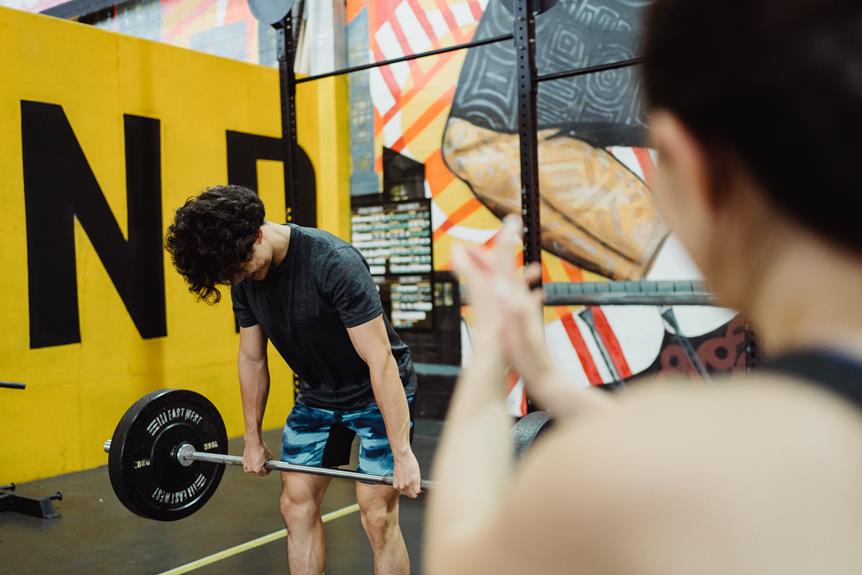In the realm of professional mixed martial arts (MMA), weight-cutting has long been a contentious issue, sparking debates surrounding safety and fairness.
ONE Championship, a prominent Asian MMA organization, has taken a unique approach to address these concerns.
In this article, we delve into the intricacies of ONE Championship's weight-cutting rules, examining their comprehensive system of weight class determination, random weigh-ins, and urine-specific gravity hydration testing.
By shedding light on this vital aspect, we aim to foster a deeper understanding of the complexities surrounding weight-cutting in professional fighting.
Key Takeaways
- ONE Championship introduced weight-cutting rules and hydration testing after a fighter's death due to dehydration in 2016.
- Fighters determine their contracted weight class based on their 'walking weight' before a fight.
- Random weigh-ins during fight camp and an official weigh-in the day before the fight ensure compliance with weight class.
- Fighters undergo urine-specific gravity hydration tests, with a value of 1.025 or below required to pass.
Background of ONE Championship Weight-Cutting Rules
The background of ONE Championship weight-cutting rules can be traced back to 2016 when they were introduced after the tragic death of a ONE Championship fighter due to dehydration.
Hydration is of utmost importance in combat sports as it directly impacts fighter performance. Weight cutting, a common practice in combat sports, involves rapid weight loss before a fight to meet a specific weight class. This can lead to severe dehydration, compromising a fighter's physical and cognitive abilities.
ONE Championship implemented new rules to address this issue. Fighters determine their 'walking weight' before a fight, which determines their contracted weight class. Random weigh-ins during fight camp ensure consistency, and an official weigh-in is conducted the day before the fight to check compliance. Additionally, fighters undergo urine-specific gravity hydration tests to ensure adequate hydration levels. Passing the test is crucial, as failure can result in disqualification.
These rules prioritize fighter safety, improve performance, and reduce the risk of dehydration-related incidents.
ONE Championship's Hydration Testing Process
To ensure fighters' hydration levels are adequately monitored, ONE Championship implements a comprehensive hydration testing process. This process involves urine-specific gravity testing, which is conducted at the start of fight week and the day before the fight. The aim of this testing is to prevent dehydration in fighters and ensure their safety inside the ring.
The effectiveness of hydration testing in preventing dehydration in fighters is a crucial aspect of ONE Championship's weight-cutting rules. By monitoring the urine-specific gravity value, which must be 1.025 or below to pass, ONE Championship can identify fighters who may be at risk of dehydration. This helps in preventing fighters from cutting excessive weight and competing in a dehydrated state, which can have serious health consequences.
However, there are pros and cons to hydration testing in ONE Championship. On one hand, it promotes the safety and well-being of fighters by minimizing the risk of dehydration-related issues. On the other hand, critics argue that hydration testing may not be foolproof and can be affected by factors such as high-protein diets and drug interactions.
Despite the criticisms, ONE Championship's hydration testing process is a significant step towards ensuring the health and safety of fighters. By closely monitoring their hydration levels, ONE Championship aims to create a level playing field and prioritize the well-being of its athletes.
Consequences for Missing Weight in ONE Championship
Fighters who fail to make weight in ONE Championship face significant consequences. The penalties for missing weight can have a major impact on the fight card.
If a fighter is unable to meet the contracted weight for their bout, there are two possible outcomes. First, the fight may be cancelled altogether, resulting in disappointment for fans and a lost opportunity for both fighters. Alternatively, a catchweight bout may be arranged if both fighters agree. However, the weight for the catchweight bout must not exceed 5% of the contracted weight class.
In addition to the impact on the fight itself, there are also financial penalties for missing weight. Fighters who fail to make weight during the official weigh-in may receive a warning and a 25% purse penalty. If the fighter fails to make weight again during the post-bout weigh-in, the penalty increases to a 50% purse penalty.
These consequences serve as a deterrent, encouraging fighters to adhere to the weight-cutting rules and ensure fair competition.
Comparison of ONE Championship and UFC Weight-Cutting Rules
The contrasting approaches to weight-cutting rules between ONE Championship and the UFC highlight the divergent priorities of fighter safety and tradition in the sport of mixed martial arts.
While the UFC allows weight cutting, ONE Championship implements strict rules to prevent dehydration and ensure fighter well-being. The effectiveness of ONE Championship rules can be seen in the reduced risk of canceled fights due to dehydration, leading to better quality fights determined by skill rather than excessive weight advantage.
The majority of the MMA community supports these rules, recognizing the importance of prioritizing fighter safety. However, UFC weight cutting challenges persist due to tradition and competition concerns.
Despite the criticisms and challenges faced by ONE Championship, their rules demonstrate a proactive approach to protecting fighters and promoting fair competition in the sport.
Criticisms and Challenges of ONE Championship's Weight-Cutting System
The validity of ONE Championship's weight-cutting system has been questioned due to concerns about high-protein diets and potential drug interactions affecting hydration test results. Critics argue that these factors may influence the accuracy of the hydration tests conducted by ONE Championship. They question the effectiveness of the testing process, pointing out that kidney adaptation and the chosen cutoff number of 1.025 may not adequately reflect a fighter's true hydration status.
Additionally, there are concerns about the lack of transparency and incomplete data regarding weigh-ins and post-bout sanctions. Despite the aim of preventing dangerous weight cuts, fighters still attempt to gain an advantage by cutting weight, leading to an increase in catchweight fights and attempts to manipulate electrolytes.
These criticisms highlight the challenges faced by ONE Championship in ensuring the health and safety of its fighters amidst the culture of weight cutting in combat sports.
Overall Assessment of ONE Championship Weight-Cutting Rules
In assessing the weight-cutting rules implemented by ONE Championship, it is crucial to recognize that concerns regarding transparency, adherence to anti-doping measures, and the prevalence of weight cutting persist within the MMA community.
The effectiveness of hydration testing in preventing dehydration has been questioned, as high-protein diets and drug interactions can affect test results.
Weight cutting has a significant impact on fighter performance, with fighters attempting to gain an advantage by cutting weight and manipulating electrolytes.
While ONE Championship aims to prioritize fighter safety and avoid fight cancellations, the lack of transparency and incomplete data regarding weigh-ins and post-bout sanctions raises concerns about the fairness and integrity of the weight-cutting process.
Despite these challenges, ONE Championship's weight-cutting rules represent a step forward in mitigating the dangers of extreme weight cutting, and the organization's commitment to improving fighter safety is commendable.
Frequently Asked Questions
How Does the Hydration Testing Process Work in ONE Championship?
Hydration testing in ONE Championship is a crucial process that aims to ensure fighter safety and performance. Fighters undergo urine-specific gravity tests before fight week and the day before the fight, with a passing value of 1.025 or below. Failure results in disqualification or a catchweight bout.
What Happens if a Fighter Fails the Hydration Test on Fight Day?
If a fighter fails the hydration test on fight day in ONE Championship, they are given a second chance to pass. However, if they fail the test again, they will be disqualified, resulting in serious consequences for their fight and potential financial penalties.
How Do Fighters Attempt to Manipulate Their Weight and Electrolyte Levels in ONE Championship?
Fighters may attempt to manipulate their weight and electrolyte levels in ONE Championship by implementing strategies such as extreme dehydration, diuretic use, and manipulating sodium intake. These practices pose potential risks to their health and performance.
Are There Any Specific Guidelines or Restrictions on Weight Cutting in ONE Championship?
Fighter safety is a top priority in ONE Championship, with specific guidelines and restrictions on weight cutting. These rules aim to prevent dangerous dehydration and ensure fair competition, promoting the well-being of the fighters.
How Does ONE Championship Prioritize Fighter Safety and Prevent Dangerous Dehydration?
ONE Championship prioritizes fighter safety and prevents dangerous dehydration through regular weighing, hydration testing, and strict weight-cutting rules. They aim to ensure healthy weight management in combat sports, reducing the risk of dehydration-related incidents and promoting fair competition.
Conclusion
In conclusion, the ONE Championship weight-cutting rules have been implemented to prioritize the safety and well-being of fighters while promoting fair competition.
The introduction of random weigh-ins and urine-specific gravity hydration testing ensures that athletes are not dangerously dehydrated during fights.
While there are criticisms and challenges to this system, it represents a significant step forward in addressing the concerns surrounding weight-cutting in professional MMA.
These rules serve as a model for other promotions in their pursuit of a safer and more equitable sport.
- 15 Best Martial Arts Weapons (Fighting & Training) - October 14, 2024
- Is Fencing a Martial Art? (Yes, 4 Reasons Why) - October 14, 2024
- 7 Best Martial Arts for Self-defense Ranked (Highly Effective) - October 14, 2024










